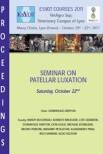Objective: To report a modification of the tibial tuberosity transposition (m-TTT) technique used to treat medial patellar luxation (MPL) in dogs, and report its complications.
Study design: Retrospective case series.
Sample population: Dogs (n = 235) undergoing MPL correction, using m-TTT (n = 300 stifles).
Methods: Medical records and client surveys were reviewed to determine complications associated with this technique and they were compared with previously reported complications using similar techniques.
Results: Short-term minor complications included low-grade reluxation (11 stifles, 3.6%), incisional seroma (nine stifles, 3%), pin-associated swelling (seven stifles, 2.3%), patellar desmitis (six stifles, 2%), superficial incisional infection (four stifles, 1.3%), pin migration (three stifles, 1%), tibial tuberosity (TT) fracture (two stifles, 0.6%), tibial tuberosity displacement and patella alta (one stifle, 0.3%), pin-associated discomfort (one stifle, 0.3%), trochlear block fracture (one stifle, 0.3%). Short-term major complications included pin migration (three stifles, 1%), incisional infection (two stifles, 0.6%), tibial tuberosity fracture (two stifles, 0.6%), and high grade reluxation (two stifles, 0.6%). Long-term follow-up examination data were available for 109/300 (36.3%) stifles. One minor complication and four major complications were documented. All long-term complications were due to pin migration. The overall major complication rate was 4.3% (13/300 stifles), with a minor complication rate of 15% (46/300 stifles). The owner survey indicated a 100% satisfaction rate.
Conclusion: The m-TTT technique yielded acceptable complication rates, with high owner satisfaction.
Clinical significance: The m-TTT should be considered as an alternative technique for treating dogs with MPL requiring a tibial tuberosity transposition.









